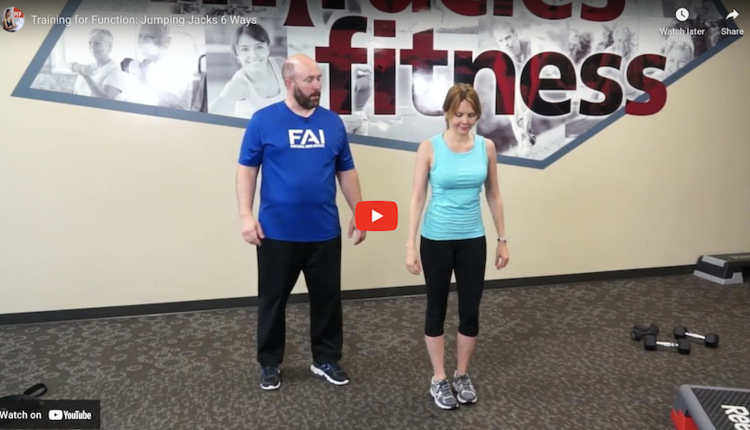The idea that money is the ultimate measure of success and achievement in life is not, in itself, true. The truth is you first have to be a well-rounded, well-adjusted individual in order to find true happiness. Without these fundamental attributes, you probably wouldn't be able to soundly enjoy the benefits that money has to offer.
The human body is very similar in that muscular strength is often perceived to be the ultimate measure of success in the physical fitness world. But if that were the case, then why do so many strong people of all ages suffer from injury, pain, dysfunction and performance disabilities? Does strength alone, when used as a major part of the physical training regimen, provide your clients with the skills and benefits they need to be strong, stable and functionally viable? The truth is: strength is only part of the equation. Power and stability, beginning deep in the core, are necessary foundations for a strong body to also be a healthy and functional body.
Let us imagine that you are granted the gift of either superior strength or infinite speed. Imagine that the strength would be strength like no other human being on this planet -- the strength to lift an automobile off the road and simply toss it across the highway. And imagine that the speed would be an incredible speed -- the ability to move in any direction: up, down, side to side; or to rotate so quickly that it looks as though you are standing still to the naked eye.
Which would you choose?
Do you want to be the strongest or fastest person on Earth? Based on traditional thinking about training and conditioning, most people would choose superior strength, not speed.
Many trainers focus on building more massive bodies for their clients, rather than building faster, more controlled, more coordinated and balanced bodies. Strength alone does not relate to quickness or speed of movement, nor does it protect you from injury due to uncontrolled acceleration or deceleration of the body. Your nervous system creates the ability for muscles to respond with exquisite balance of contraction, precise metering of force production, and force reduction to refine movement and prevent injury. Possession of strength alone does not ensure that you can swing the bat fast enough to hit a 100 mile per hour fastball, or put one foot in front of another to prevent the loss of balance and falling. Only when you have speed and control of movement along with adequate strength, will you have the right combination!
According to Sir Isaac Newton, force combined with velocity translates to speed, which equates to power. Therefore a "powerful person" really refers to a person with great speed and control of their body, not necessarily massive strength. The ability to move quickly and to accelerate or decelerate balances the body to perform with greater accuracy and with greater control. Strength is very important, but the integration of strength and speed of muscle contraction is key.
As a Physical Therapist, it has always been my contention that the difference between acute rehabilitation and the highest level of professional sports training is simply where you are along the path or spectrum of training. Preparing for activity at any age requires attention to the elements that help us to perform better functionally. For this, we need to address the neuromuscular system using sensory and motor training; multi-planar, multi-directional, and dynamic response training; control of force production and force reduction. We have receptors in our body called proprioceptors located in the skin, joint capsules, ligaments, muscle bellies and tendons that help us know where we are in space. That, coupled with skeletal muscle activation, gives us new feedback from our movements; and more communication between the proprioceptors, brain and muscles provide the functional loop we need to become more powerful in everyday life.
It is important to consider the physical and functional strength of an individual to know how best to help him or her achieve their goals. Muscle endurance also becomes a factor in training because as a person fatigues, they lose coordination, which translates to slower reaction time, decreased functional performance and an increased risk of injury. The best way to determine how well a person is equipped to perform a specific task is to watch them during that activity.
There are a number of functional assessment protocols available to test men and women of all ages, involving gait speed, timed functional reach, sit to stand, arm curls for time and strength, single limb stance, balance reach, medicine ball throws, prone progression skills, active dynamic flexibility and more. The key to choosing the proper assessment for your client is to first understand their needs and wants, coupled with their personal performance goals. A young adult male or female may be more interested in improving response skills and accuracy during their tennis game. A golfer may be hoping to improve their swing mechanics and accuracy. An older adult may want to add a walking program to their exercise regimen, so they can do more traveling and hiking on uneven terrain. For some, functional performance includes the need to reproduce movement skills, combined with minimal strength, to perform the regular activities of daily living.
Your exercise prescription should combine the use of strength training (progressive resistance training) and functional training, which incorporates skills that will improve muscle contractile velocity, muscle endurance and tri-plane movement patterns to challenge the body. Also include movements that shift weight from one limb to the other, and activities that require controlled force production movement (concentric contractions) combined with reciprocal force reduction movement (eccentric contractions). This focuses on stabilization and balance in a multi-directional, progressive way, with simple to more complex movements and speed variations.
Plan to build the body from the center out, focusing on deep, dynamic, core stabilization using proximal stability before distal mobility. Initially, emphasize a wider base of support, which allows for a lower center line of gravity to fall within the broader base of support and provides a more solid foundation for balance. Progress the client by narrowing the base of support or adding a single limb stance to raise the center line of gravity, allowing the center of gravity to migrate outside the base of support for a more challenging, dynamic workout. Remember, muscle power is more closely related to functional performance then pure strength gains. Adding tri-plane movements by moving progressively from sagittal to frontal and transverse planes will require greater control of muscle coordination and reaction time.
Be creative when combining upper and lower body tri-plane speed drills by getting down on the floor and rising to a standing position, reaching outside your base of support, adding resistance to the extremities through various modes of application and be aware of the structural and biomechanical functional improvements you see. Your exercise program becomes a part of your ongoing assessment of your client's progress and needs.
Transforming your training program design from a more traditional single-plane emphasis on isolated strength training may require some time for further educational development and tools, but the goal is to provide you with an expanded asset base of training potential, assessment skills and ultimately the implementation of a more functional tri-planar training regimen. And remember to have fun and enjoy a more comprehensive approach to function, wellness and program design that will better meet the needs of your clients of all ages.
Bruce Hymanson is the creator of the Bodyblade and the developer of the Bodyblade exercise training system. In 1991, Bruce introduced Bodyblade training to rehabilitation, professional sports, personal training and most recently, circuit, interval and group training. Today Bodyblade training courses are recognized and presented internationally. www.bodyblade.com











